Susan Appleyard's Blog, page 15
April 19, 2017
Chill with a Book Award
[image error]
Today is a great day. My first novel Queen of Trial and Sorrow has been awarded a Chill with a Book Award. Thank you, Pauline!
See it here: http://www.chillwithabook.com/2017/04...


March 19, 2017
MM Bennetts Award
A writer and person of distinction, MM Bennets, died in 2014 after a full and rewarding life. An award was set up in her name so that she would not be forgotten and to encourage other authors of historical fiction. I am one of those authors, and I am proud to be included in the list of this year’s finalists. I wish to thank those who are overseeing the awards in the name of a very special lady.
[image error]mmba semi-finalist badge


February 26, 2017
Game of Successors, Part 3: The Partition of Babylon
Another great blog about what happened to Alexander’s empire after his death.
With Meleager’s revolt ended and the Macedonian succession issue momentarily solved, Perdiccas at last had the chance to focus his attention to matters outside of Babylon. He must have been dismayed by what he saw. The empire was in disarray; news of Alexander’s death had spread, resulting in disorder and unrest in some of the satrapies; and still other satrapies had been without a formal leader for some time. He could see that, if the empire was to survive under his regency, something had to be done.
As he had done in the wake of Alexander’s death, he returned to the idea of a council to address the situation. This time, its goal would be to partition and reorganize the provinces. He intended the result to benefit the empire, but it’s likely that he hoped it would benefit him as well. After all, he could portray the partitioned satrapies…
View original post 800 more words


February 6, 2017
It’s Alive!
Monkey business from Xina Marie Uhl.
Yes, I am resurrecting my blog from the dead. Lazarus, come forth! I am not so sure about this header photo, but it is a bit quirky and has books on it. Plus it gives the illusion that I look like the woman on the bed, which I most assuredly do not.
I have decided to change the focus of my blog from an unfocused mishmash of travel posts and writing/marketing ideas to something near and dear to my writer’s heart:
RESEARCH.
Ah, research. I could spend my life on you if I had all the time in the world. Now, on the face of things you might be saying, “How boring!” But, my friend, that couldn’t be further from the truth. Case in point being this article from the June 15, 1908 edition of Perth, Australia’s The Daily News:
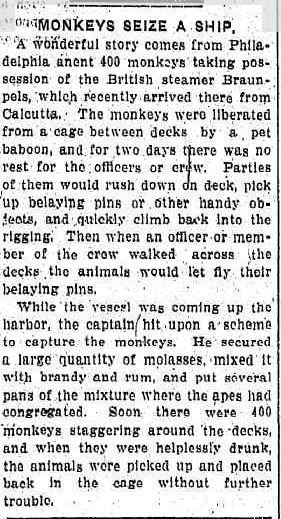
Now don’t tell me that rampaging monkeys released by…
View original post 45 more words


January 21, 2017
Writers in the sun.
All of you who live in the northern U.S., Canada, or other frozen climes, read no further. I spend six months of the year, every year, in Mexico, so I was delighted to discover a writers’ group only a ten-minute drive from my house. Amazingly, because this is a small town, there are about fifteen of us, with a wide range of experience in the writing field, including two editors. We meet once a week in the air conditioned VIP lounge of the Marina and sit in comfortable armchairs or sofas. Our view through the bougainvillea-framed windows is of the boats – from little fishing craft and floating palaces. Could anything be more perfect? I am in heaven.


January 11, 2017
How to bring down a government.
Let me state right away that I am not advocating sedition. This post is to introduce my readers to a fascinating woman who did just that.
You know that song: Whatever Lola wants, Lola gets? Meet Lola.
[image error] Lola Montez c.1855
She was born Marie Dolores Eliza Rosanna Gilbert in County Sligo in Ireland in 1821. When Eliza (as she was known) was two her father, a soldier, was posted to India. Shortly after the young family arrived, her father died of cholera. Her mother, who was only nineteen, married another soldier.
Eliza was a wild child and spoiled. It was decided to send her to Scotland to be managed by her stepfather’s Calvinist father. At the age of ten, she moved again, this time to Sunderland and the care of her stepfather’s sister, who had set up a boarding school there. After Sunderland, came Bath to complete her education.
At the age of sixteen, to spoil her mother’s matrimonial plans for her, Eliza eloped with and married Lieutenant Thomas James. Five years later, back in India, they separated. Eliza became a professional dancer, adopting the stage name Lola Montez the Spanish dancer. Debuting in London, she was recognised as Mrs James, which put a damper on her burgeoning career. After dancing in a few European capitals, she settled in Paris, where she met and had an affair with Franz Liszt, who introduced her to George Sand. As part of that literary circle, she also made the acquaintance of Alexandre Dumas, pere, and possibly has an affair with him, too. Meanwhile, no doubt she was accepting favours from wealthy gentlemen to pay for her extravagant lifestyle. One of her lovers was challenged to a duel, shot and killed. Whether Lola had anything to do with the quarrel, I don’t know.
In 1846, still only twenty-five-years-old, she arrived in Munich preceded by a blare of trumpets and an improved pedigree. She was of noble Spanish birth, kin to both the French and Spanish Bourbons and the wife of an English peer. Her dancing had taken London by storm. In a sense, that part was true. She had been driven off the stage of Her Majesty’s Theatre by a storm of hisses. Never mind, Munich was impressed, although on the two occasions when she danced for them, the people confirmed London’s verdict. It was probably at the theatre that she met King Ludwig I. He was a cultured man and patron of the arts. He often honoured visiting artistes by inviting them to the Residenz.
[image error] King Ludwig I of Bavaria
Well, she couldn’t dance, but she must have been beautiful, judging by her string of eminent lovers, and she soon became the mistress of Ludwig, who was sixty at the time. He immediately bought her, and furnished, a large house near the Residenz, where he spent a great deal of his time. If Lola had confined herself to shenanigans in the bedroom with her ageing lover, all might have been well. But she was vain, arrogant, given to bursts of temper, loved the limelight, and, like most royal mistresses, greedy. She wanted to be naturalised as a Bavaria citizen so that Ludwig could bestow a title on her. In spite of opposition from government and people, the king made her Countess of Landsfeld and a canoness of the Order of St. Theresa, an honour usually reserved for Bavarian ladies of the highest birth. To maintain her new dignities, he also granted her a generous allowance.
At this point, Lola began interfering in politics, in opposition to the Ultramontanes, the ruling party. Her house became a gathering place for social climbers, intriguers and malcontents, and Lola herself was the heroine on a new stage. As her influence grew, so did the opposition to her. Karl von Abel, the Prime Minister, published a document against the king’s proposal to naturalise her and was promptly dismissed. His successor was more accommodating and Lola obtained the coveted certificate. Students rioted, led by their Ultramontane professors. On one occasion, Lola was mobbed in the street. She defended herself valiantly with her riding whip until she could take refuge in a church. The Ultramontane professors were dismissed. The government fell.
A new government was formed by Prince Ludwig von Oettingen-Wallerstein, which became known as the Lolaministereum. Yes, the talentless adventuress from Ireland became the virtual ruler of Bavaria because the besotted king could deny her nothing. But worse was to come. The revolutions of 1848 were sweeping Europe and more riots broke out in Munich. The king dismissed the Lolaministereum. (How she must have wept!) Feeling he had lost the love and trust of his people, Ludwig abdicated in favour of his eldest son.
Lola had no intention of spending the rest of her life catering to the needs of an old ex-King, who possibly might blame her for the loss of his throne. She was ripe for more adventures. After spending brief periods in Switzerland and France, she returned to London where she met and married a cavalry officer named George Heald, who had just come into an inheritance. Unfortunately, the terms of her divorce from Thomas James stipulated neither could remarry while the other was alive. To avoid bigamy charges, the newly-married couple made haste to the continent, living for a time in France and Spain. Within two years the relationship was over and George, apparently, drowned.
In 1851, still only thirty-years-old, Lola set off to make a new start in the U.S., where she once acted in a play called Lola Montez in Munich. She married a newspaper man and moved to California, but the marriage soon failed. A doctor named as co-respondent in the divorce proceedings was murdered soon after.
In 1855, Lola was on the hop again, this time to Australia to entertain miners during the gold rush. Apparently, at the Royal Theatre in Melbourne, while prancing about the stage, she raised her skirt so high the audience could see she wore no underwear. Not surprisingly, her performance resulted in a blistering attack on her morals by a newspaper and decent folk stayed away from the theatre which began to lose money. Mind you, the miners were more appreciative.
The following year she returned to San Francisco. Somehow, during the voyage, her manager fell overboard. (Has anyone noticed how men around Lola tend to die in suspicious circumstances?) Getting a bit long in the tooth, she was unable to make a comeback.
She spent her last years doing good work among rescued women, but she was beginning to show the signs of syphilis. The body that had served her so well and which she had used so productively was wasting away. She died on January 17th, 1861 at the age of 39.
There’s probably a moral here somewhere, but I won’t go there. Lola was one of those women who rejected the traditional social mores of the Victorian age and lived life as she pleased when the lives of most women were so circumscribed. Good for her!


December 24, 2016
Interview with Award Winning Author Susan Appleyard
A wonderful interview by Stephanie Moore Hopkins of Layered Pages.
I’d like to welcome back award winning author Susan Appleyard today. Susan was born in England, which is where she learned her love of history and writing. She has applied these two loves ever since in writing historical fiction. Her first two book were published traditionally and she also has five ebooks with another to be published soon after Christmas. Susan is fortunate enough to spend half the year in Ontario with kids and grandkids, and the other half in Mexico with sun and sea and Margaritas on the beach. (No prizes for guessing which months are spent where!)
 Hi, Susan! Thank you for visiting with me today to talk about your award winning book, In a Gilded Cage. Please tell me the premise of your story and the era your story takes place.
Hi, Susan! Thank you for visiting with me today to talk about your award winning book, In a Gilded Cage. Please tell me the premise of your story and the era your story takes place.
Hello, Stephanie, as an avid follower of your blog, I’m delighted to be here. My novel…
View original post 818 more words


December 16, 2016
Cover reveal
Here is the cover for my novella produced by the talented Elle at ejrdigitalart.com
[image error]Cover Dark Spirit


December 3, 2016
Ludwig II and the composer
The first music Ludwig heard of Richard Wagner’s was the opera Lohengrin performed at the court theatre in Munich. For the romantic and imaginative and fifteen-year-old, it was almost a spiritual experience. He was enraptured.
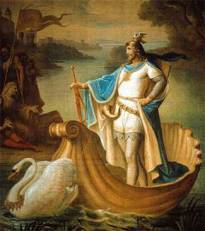 Painting of Lohengrin by August von Heckel
Painting of Lohengrin by August von HeckelThree years later, in 1864, Ludwig became King of Bavaria. His father was barely cold before Ludwig sent his principal private secretary, Pfistermeister, to find the composer and invite him to Munich. Wagner had been travelling around Europe, struggling to get his works performed and put bread on the table. Poor Pfistermeister had a hard time with his commission because Wagner, as usual, was having money difficulties and didn’t want to be found. It required a great deal of travel, and patience, on the secretary’s part, but eventually he ran his prey to ground, handed him a letter and gold ring from Ludwig and asked if he wanted to go to Munich. Wagner must have tripped over his feet in his rush.
The following day the two met at the Residenz for the first time and it was a dream come true for both. Thus began the odd friendship between the sensitive boy-king and the mercurial composer, thirty-two years his senior. What Ludwig saw in Wagner was a man who could bring the almost moribund tales of German folklore to brilliant life. What Wagner saw in Ludwig was a cash-cow. No, that’s not quite fair. In Ludwig, he found someone who understood him and his music as no other, with the exception of his wife, Cosima, the daughter of Franz Liszt. But there is no doubt that Ludwig was a very generous patron and Wagner was a – not always grateful but always eager – receptacle of that generosity.
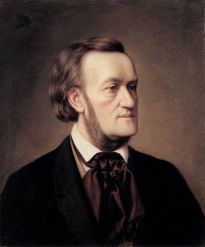 Richard Wagner
Richard WagnerTo Ludwig, Wagner was The Great Friend. To the people of Munich, he was a political hothead who had been chased out of Dresden for his left-wing activities. He was also seen as an impoverished parasite who was bleeding funds from their impressionable young monarch to support an extravagant lifestyle. No one saw him as the great composer he is today.
There were articles in the newspapers, gossip in the streets. Cosima, who was then Hans von Bulow’s wife, had a child that was believed (correctly) to be Wagner’s. Ludwig had no idea about the relationship between the two. Wagner finally went too far when he started interfering in politics, just as he had in Dresden, by trying to get rid of the prime ministers and the private secretary who had wandered all over God’s Acre to find him and bring him to Ludwig. The prime minister threatened to resign unless Wagner was sent away. As besotted as he was by the composer, Ludwig never allowed his influence to extend into the political arena. Wagner lost that battle and left Munich.
Between the time they first met and when Wagner was sent away, a period of nineteen months, Wagner received from Ludwig forty thousand florins, just over one-eleventh of the king’s private income for the period.
Wagner’s exile lasted six years. During that time they wrote continuously. Ludwig visited Wagner at his new home on Lake Lucerne and Wagner paid several visits to Munich. There the two discussed plans to build a new theatre in Munich that would be worthy of Wagner’s epic works. The Muncheners didn’t want it, so the foundation stone of the Festival Theatre was laid by Wagner outside the little town of Bayreuth on his fifty-ninth birthday. When the project ran out of funds, Ludwig donated three hundred thousand marks (fifteen thousand pounds).
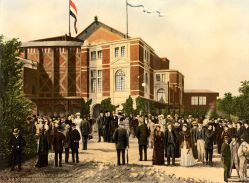 The Festival Theatre in Bayreuth
The Festival Theatre in BayreuthOn the evening of August fifth, 1876 the new theatre opened with the first complete performance of Wagner’s Der Ring des Nibelungen.
In spite of the defects of character in both men; in spite of the demands and egotism of genius, the quarrels and separations, the friendship between the king and the composer lasted until February thirteenth, 1883, when Wagner died in Venice of a heart attack. Ludwig was deeply grieved by the death of The Great Friend. He never heard Wagner’s music played again and covered all the pianos in his palaces with black crepe.
‘I have rescued him, and now hope that I have preserved for the world, in him, one of my best works.’ – Ludwig.
In my soon to be published novella Dark Spirit I have written about the last months of Ludwig’s unhappt reign.
All pictures are in the public domain.
Attribution of the third picture. By …trialsanderrors – Wagner Festspielhaus, Bayreuth, Bavaria, ca. 1895, CC BY 2.0, https://commons.wikimedia.org/w/index.php?curid=11160764


November 26, 2016
How Ludwig II’s toothache contributed to 2 world wars.
Yes, in know you are a little sceptical about the title of this post, but it’s only a bit of a stretch. It happened like this. In 1866 Prince Otto von Bismarck, Chancellor of Prussia fabricated a war against the mighty Austrian empire and, astonishingly, won in just 7 weeks. Austria was kicked out of the German Federation and Prussia adopted her former German allies, including Bavaria.
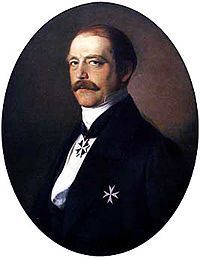 Bismarck, the Iron Chancellor
Bismarck, the Iron ChancellorFour years later, Bismarck’s target was France, considered invincible – by all except Bismarck. Although he hated war, King Ludwig was forced by treaty to send troops to the support of Prussia. I don’t need to go into the details of the Franco-Prussian War. It is sufficient to say that 10 months after the first salvo, Prussian boots were marching along the Champs Elysees.
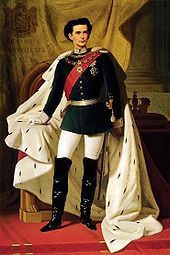 Ludwig in his coronation robes
Ludwig in his coronation robesBismarck was now in a position to embark on his ultimate goal: the establishment of a German Empire. Ludwig had high hopes that if an empire was to be formed he might be chosen as its head. After all, he was the direct descendant of the Holy Roman Emperors of yore. But Bismarck hadn’t fought 2 wars – actually, 3; I forgot to mention the Schleswig-Holstein war – in order to elevate Bavaria. No, he wanted to unify Germany under Prussian control. Consequently, he founded the Second Reich. The first was the Holy Roman Empire, the third Hitler’s regime sixty years later.
One by one the other German states signed the unification agreement. Bavaria was promised independent diplomatic representation, a separate army in peacetime, her own railway and telegraph services, control of beer taxes (very lucrative in Bavaria) and the right to grant citizenship if the king would sign. But Ludwig knew it all meant a serious curtailment of his sovereignty and his people knew it would be the end of the old Bavaria.
Bismarck wanted something else from Ludwig. He wanted Ludwig to write a letter to King Wilhelm, appealing to him to accept the imperial crown.
Ludwig was invited to Versailles to join in the celebrations. In order to entice him, it was even suggested he should be offered the bedroom of Louis XIV himself, as it was well-known he admired the absolutist kings of France and was expected to respond to the prospect with transports of delight. He was certainly tempted but (a) he hated his Prussian cousin, Crown Prince Wilhelm and (b) he was already showing a tendency toward isolationism. After some wavering, he instructed his court secretary to pretend he was too ill to travel. The Bavarian cabinet left without him and joined the envoys of the smaller German states.
An impasse had been reached. Ludwig empowered his old friend and Master of the Horse, Count Holnstein, to go to Versailles in secret and determine if the imperial crown was out of his reach and how far Bismarck would go to obtain his cooperation. Holnstein was not the friend Ludwig thought he was. In fact, he decided at some point that the forceful all-powerful chancellor was the man to serve and succeeded not only in getting an interview with him but also persuaded him to draft the letter himself and Holnstein would convince Ludwig to sign it. Off Holnstein went back to Bavaria with the precious letter.
When he arrived, Ludwig was in bed with a toothache. It was a malady he suffered from frequently, as he was fond of sweets. At the end of his life, at the age of forty, he had few teeth left. He was in such excruciating pain that initially, he refused to receive his friend. Holstein practically forced his way into the king’s presence and saw that he had been presented with a golden opportunity. Ludwig was alone, except for servants, and vulnerable. The count declared he had to leave to catch a train for Versailles before 6:30, and Ludwig must sign the letter before then. Failure to do so could result in him being deposed and forced to flee. Poor Ludwig was in a very susceptible mood and Holnstein kept the pressure up until Ludwig asked him to send for pen and notepaper. He didn’t sign the letter Holnstein had brought, and he didn’t copy it word for word. Instead, he rewrote it to give more power to the princes of the states in the new Reich. It became known as the kaiserbrief. Holnstein gleefully dashed off.
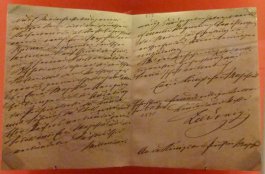 The kaiserbrief
The kaiserbriefSo Prussia, which had amply demonstrated its pugnacity in 3 wars within 10 years now had the power and prestige of an empire. It had crushed Austria and humiliated France. And in the Crown Prince mention above, a.k.a. Kaiser Wilhelm II, it also had an autocratic and possibly unstable leader with a muscular expansionist policy.
I hate to blame anything on Ludwig – he was such a troubled soul. But I can’t help feeling that without his toothache there would have been no kaiserbrief, and without the kaiserbrief, there would have been no imperial Germany, and without the empire, there would have been no First World War, and with no First World War, there would have been no Second World War.
It’s really quite amazing what little occurrences, inconsequential at the time, might lead to.
Ludwig II is the main character of my soon-to-be-published novella, Dark Spirit.








